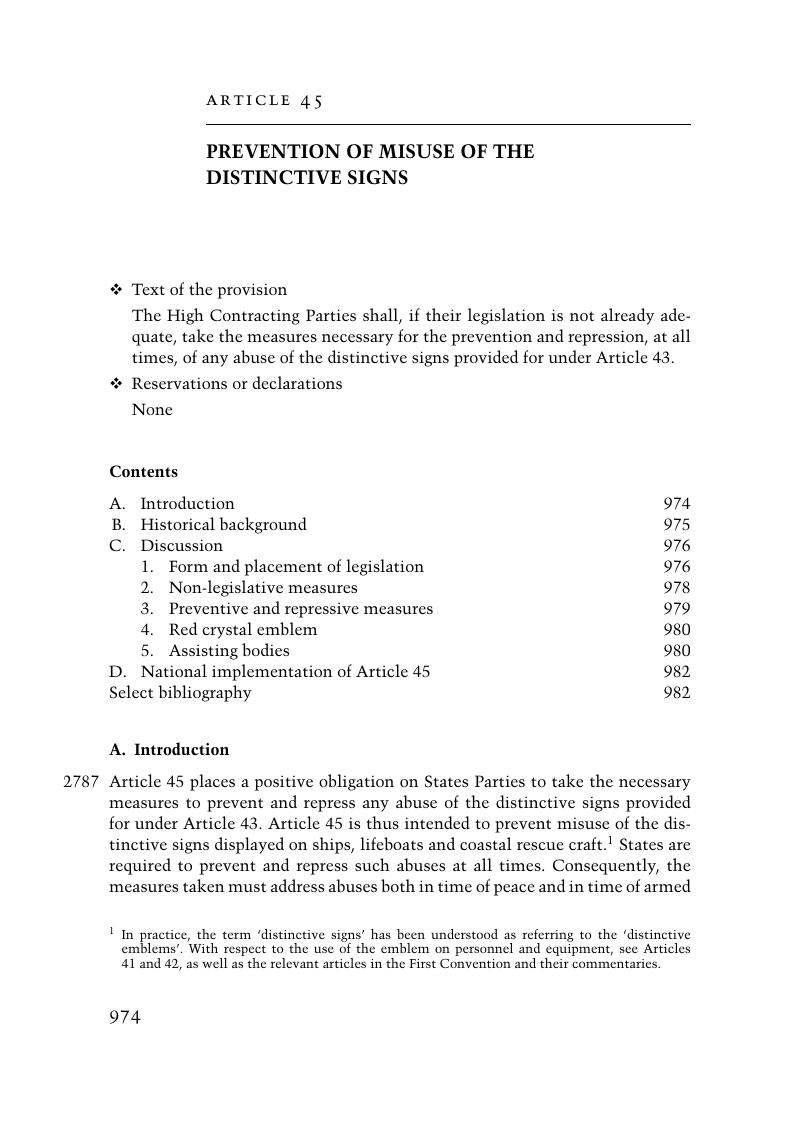 Commentary on the Second Geneva Convention
Commentary on the Second Geneva Convention Book contents
- Commentary on the Second Geneva Convention
- Commentary on the Second Geneva Convention
- Copyright page
- Contents
- Foreword by Peter Maurer
- Acknowledgements
- Abbreviations
- Introduction
- Preamble
- Chapter I General Provisions
- Chapter II Wounded, Sick and Shipwrecked
- Chapter III Hospital Ships
- Chapter IV Personnel
- Chapter V Medical Transports
- Chapter VI The Distinctive Emblem
- Article 41 Use of The Emblem
- Article 42 Identification of Medical and Religious Personnel
- Article 43 Marking of Hospital Ships and Coastal Rescue Craft
- Article 44 Limitation in the Use of the Distinctive Signs
- Article 45 Prevention of Misuse of the Distinctive Signs
- Chapter VII Execution of the Convention
- Chapter VIII Repression of Abuses and Infractions
- Final Provisions
- Testimonium and Signature Clause
- Sources
- Index
- References
Article 45 - Prevention of Misuse of the Distinctive Signs
from Chapter VI - The Distinctive Emblem
Published online by Cambridge University Press: 30 November 2017
- Commentary on the Second Geneva Convention
- Commentary on the Second Geneva Convention
- Copyright page
- Contents
- Foreword by Peter Maurer
- Acknowledgements
- Abbreviations
- Introduction
- Preamble
- Chapter I General Provisions
- Chapter II Wounded, Sick and Shipwrecked
- Chapter III Hospital Ships
- Chapter IV Personnel
- Chapter V Medical Transports
- Chapter VI The Distinctive Emblem
- Article 41 Use of The Emblem
- Article 42 Identification of Medical and Religious Personnel
- Article 43 Marking of Hospital Ships and Coastal Rescue Craft
- Article 44 Limitation in the Use of the Distinctive Signs
- Article 45 Prevention of Misuse of the Distinctive Signs
- Chapter VII Execution of the Convention
- Chapter VIII Repression of Abuses and Infractions
- Final Provisions
- Testimonium and Signature Clause
- Sources
- Index
- References
Summary

- Type
- Chapter
- Information
- Commentary on the Second Geneva ConventionConvention (II) for the Amelioration of the Condition of Wounded, Sick and Shipwrecked Members of Armed Forces at Sea, pp. 974Publisher: Cambridge University PressPrint publication year: 2017
